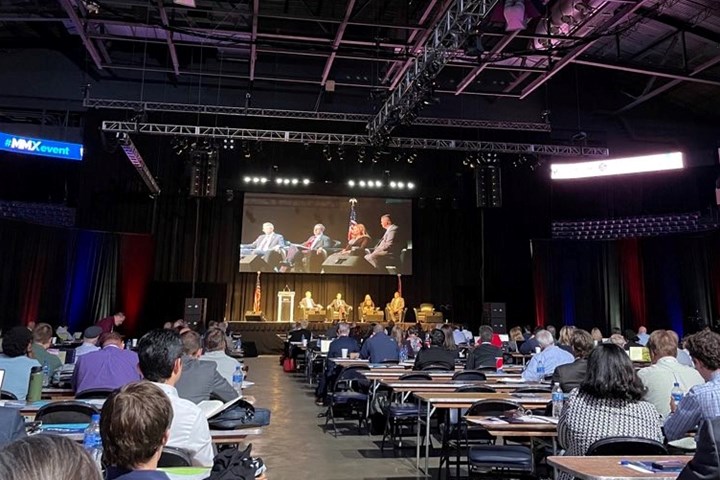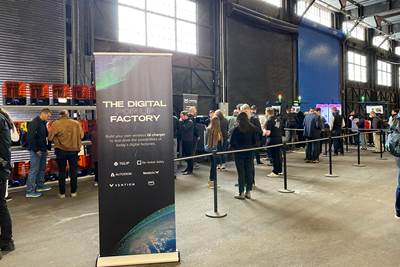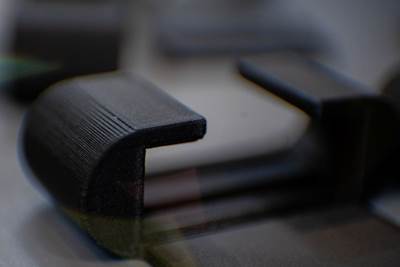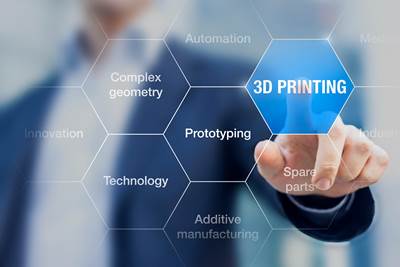
Speakers addressed AM challenges related to adoption, qualification, workforce and more at MMX 2022. On the stage: John Wilczynski, Brandon Ribic, Kimberly Gibson, Josh Cramer of America Makes.
Additive manufacturing (AM) is full of promise, but it still faces many barriers in adoption and the pursuit of scale. Overcoming these barriers will take more than industry or academia or government working in isolation; collaborative efforts will be key to solving AM’s challenges in the near term, and building an advanced manufacturing base over the long term.
Such was the focus at this year’s America Makes Members Meeting & Exchange (MMX), held in Youngstown, Ohio, August 16-19, 2022. The first in-person MMX since 2019, the event was comprised of two full days of conference sessions led largely by America Makes members, plus open houses at local facilities and a 10-year celebration for the public-private partnership.
Throughout the conference, speakers emphasized the gaps that need to be closed to bring additive manufacturing’s reality closer to its promise. But in recognizing the real and difficult challenges that lay ahead, the tone of the event was largely pragmatic. Rather than dwell on today’s difficulties, speakers and attendees tended to focus on actions and resources that can be applied to solve them. Here are some of the challenges identified, and perspectives on those next steps:
Adoption is proceeding unevenly.
There is an imbalance in the types of companies adopting additive, with large and nontraditional businesses embracing the technology more rapidly than medium and small manufacturers. Part of the challenge is educating potential users. “The first issue is awareness of the technology’s capacity, its value and its limitations,” said Jeff Hemenway of Stratasys during a panel discussion on building and scaling the AM supply chain. Today, many OEMs are better versed in additive manufacturing than their supply bases, because they have the resources to establish AM centers and explore the technology. Now, to close this knowledge gap, some OEMs like GM are finding themselves in the position of acting as a service bureau printing parts for their own suppliers.
Printer manufacturers frequently play the same role for their customers as they consider or start to ramp up with additive manufacturing technology. Rick Lucas of ExOne/Desktop Metal noted that “Customers are willing to take a small bite; they’re just not willing to bite the whole apple”; gaining their confidence via printing services all the way through developing business models is an ongoing effort. Greg Hayes of EOS agreed that in a “perfect world” printer suppliers would not be making parts for customers, but for now this is the reality of changing the status quo. Supporting and educating customers remains necessary to help users achieve scale production.
Barriers to entry into AM persist, especially for small businesses.
Getting into additive manufacturing (and embracing all the disruption it brings) remains costly, and often cost-prohibitive for smaller operations. Businesses hesitate to invest in what is still seen as an emerging technology. Susan Helper, senior economist of the White House Council of Economic Advisers summarized the challenge thusly: “It’s a chicken and egg problem. Manufacturers don’t want to add the technology if they don’t think there will be demand. OEMs don’t want to specify it if they don’t think there will be a supply.”
The U.S. government has at least two roles to play here, Hayes argues, both as a customer itself to help create demand and as a facilitator to support adoption in private industry.
The small business challenges exist both for AM users and providers; Samantha Snabes of 3D printer supplier re:3D pointed to lengthy payment terms common with top Fortune companies as a strain on the resources of smaller suppliers; certification fees are another costly challenge. Financial burdens like this could be alleviated with government support like an escrow program to pay small businesses faster, and inviting these businesses to be part of standards development.
Accelerated and more flexible paths to qualification are needed.
In a talk that looked at examples of additive manufacturing in the U.S. Air Force, Charles Ormsby of the Air Force Research Laboratory (AFRL) pointed out that additive manufacturing has been relegated to “point-by-point solutions” in which individual production parts are qualified based on unique printer serial numbers. The certification process is long and expensive, and not conducive to change because any modification means running through the entire process again.
“That doesn’t scale, or get us to distributed manufacturing,” Hemenway says; each new part practically demands a new, dedicated printer under this model.
New methods for qualification need to “balance practicality and vigor.”
Thus, additive manufacturing needs a new model for qualification. “We need to ask, ‘What should be measured?’ and ‘How much measuring should we do?’” says Brandon Ribic of America Makes, calling for a “balance [of] practicality and vigor” in any future qualification strategies.
Collaboration can and should also play a role in reducing the costs and burden of qualification on any given additive manufacturer. “If two large companies qualify the same material, can we combine that?” asks Kimberly Gibson, America Makes, pointing out current redundancies. A new Additive Manufacturing Qualification program from the organization is coming later this year that will explore how to requalify parts made through additive and other advanced manufacturing processes. According to Helper, creating access to qualifications for specific machines and materials will also be a focus for AM Forward, the private sector initiative supported by the federal government announced earlier this year.
Democratization is coming.
Additive will make manufacturing more accessible, but not necessarily in the “every printer in a home” sense. Rather, democratization will look more like increased AM capacity in the places where it is needed, to support on-demand, agile manufacturing. In his talk on the Department of Defense’s priorities for manufacturing, science and technology, Kevin Geiss of the AFRL referenced the need to make 3D printing accessible to warfighters, both to provide low-cost, fast replacement parts and to enable individuals with ideas to make them a reality. Ormsby also invoked leveraging the “wisdom of the warfighter” to create new solutions and bringing additive production to the end users — who are now more likely to be digital natives for whom 3D printing is simply a tool, rather than an innovation.
Democratization means supply chain redundancy — and resiliency.
But bringing production closer to end users is not just about reducing shipping logistics and supporting new ideas; it also means creating a robust supply chain with multiple manufacturers who can supply a given part. Furthermore, democratization can ensure a digital inventory by making data packages about qualified parts available wherever they are needed in the future.
Solving the qualification challenges described above will be key to making this possible. Today it’s a seven-year process from a new part’s inception to having the capacity in place to deploy it as a qualified part for the Air Force, Ormsby stated. That cycle won’t be sustainable for the innovation on the horizon. “We are aiming [to qualify] 200 new part numbers per year,” he says. That means faster, more agile routes to qualification are needed, routes that support qualification based on part families and that can accommodate change, including deploying production to the printer closest to the user.
Additive manufacturing has multifaceted workforce challenges.
Problems with printer repeatability and qualifying parts are “engineering problems, and engineering problems can be solved,” Hayes says. “Having a person drive change? That’s not an engineering problem — that’s a mindset.”
Current manufacturers who are applying additive manufacturing face this mindset challenge all the way from the C-suite down to how the existing workforce is trained. Michael McGrath of McGrath Analytics argued for broader skills development than teaching operators to run a specific printer or system. “Don’t train just on the ‘how’, but also the ‘why,’” he says. “Equip [employees] to operate more than one machine.”
But that focus on the “why” applies throughout the organization. Manufacturers have to think broadly about the potential benefits that additive brings, and be willing to disrupt their organizations for the sake of those benefits. “If you look at 3D printing as a substitutional technology, you come to a dead-end pretty quickly,” in terms of applications, Hayes says.
“The next generation was born digital.”
As next-generation professionals enter the workforce, many of these mindset challenges may start to fade. “The next generation was born digital,” Ormsby says. “They think this way already.” The difficulty may not be so much in changing minds as getting in front of those minds in the first place, and exposing students to careers in additive manufacturing in college, high school and even earlier.
Related Content
3D Printed Spares, Electrification and Cool Parts: Top 10 Stories of 2022: AM Radio #31
Our top articles and videos from 2022 reflect increasing use of additive manufacturing for replacement parts; growing applications for electric motors; and a maturing user base. Read through the top 10 list or listen to the AM Radio podcast episode all about these stories.
Read MoreWhat Does Additive Manufacturing Readiness Look Like?
The promise of distributed manufacturing is alluring, but to get there AM first needs to master scale production. GKN Additive’s Michigan facility illustrates what the journey might look like.
Read MoreSeurat: Speed Is How AM Competes Against Machining, Casting, Forging
“We don’t ask for DFAM first,” says CEO. A new Boston-area additive manufacturing factory will deliver high-volume metal part production at unit costs beating conventional processes.
Read More3D Printed Replacement Clamp for an F-16 Aircraft: The Cool Parts Show #54
3D printing is a valuable addition to sustainment programs, but only if printed parts can be qualified as fast and flexibly as they can be made. In this episode of The Cool Parts Show, we look at the clamp that won the Air Force’s Approval Sprint Challenge designed to address this need.
Read MoreRead Next
Propelling the Digitization of Manufacturing
The past three years have presented a range of challenges for manufacturers, accelerating the adoption of advanced, digital manufacturing technologies. The 2022 Formlabs Digital Factory Event reflected on the industry’s progress and its future.
Read MoreIs a Functional 3D Printer Network Possible? Automation Alley’s Project DIAMOnD and the Industry 4.0 Future
The initiative that placed 3D printers at more than 300 Michigan manufacturers is laying the groundwork for a future in manufacturing that is digital, distributed and largely additive.
Read MoreAmerica Makes Announces 3 Project Calls Totaling $4.6 Million in Awards
Project opportunities focus on utilizing additive manufacturing to address immediate and mid-term needs of the domestic supply chain.
Read More

.jpg;width=70;height=70;mode=crop)





















